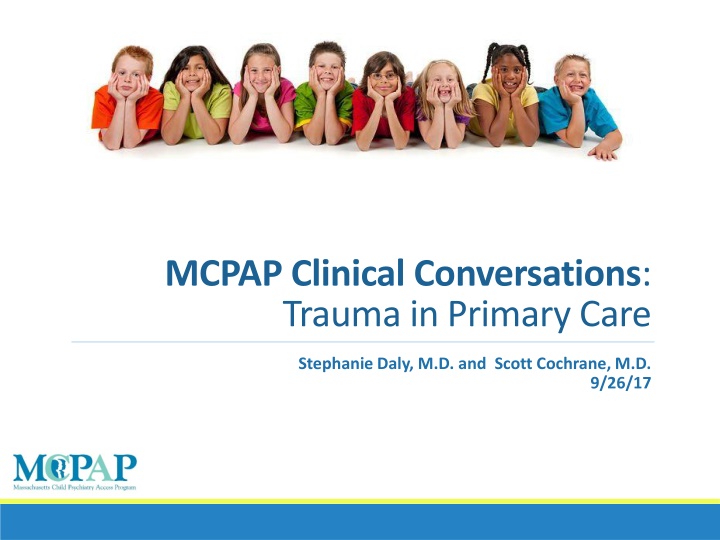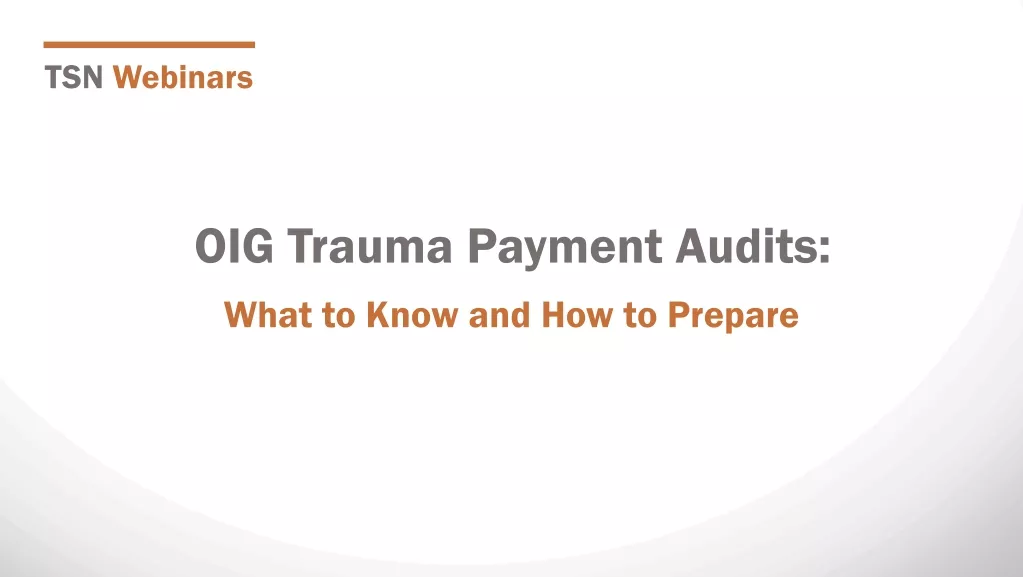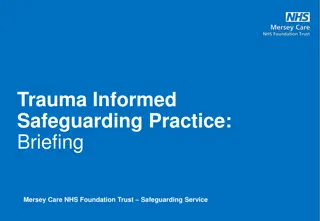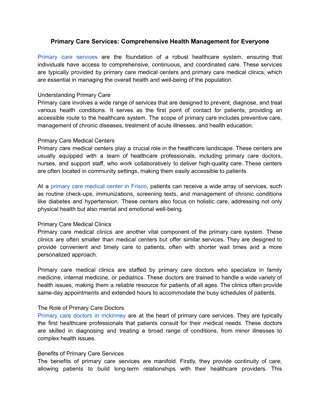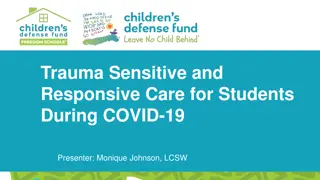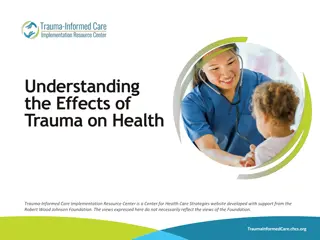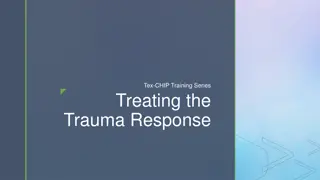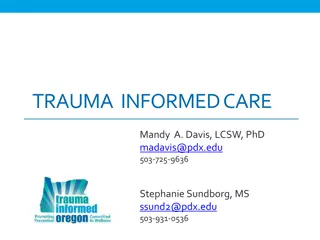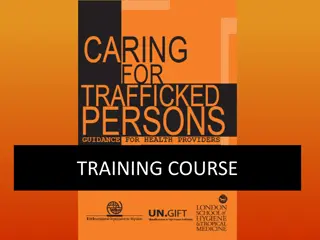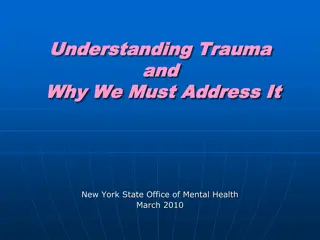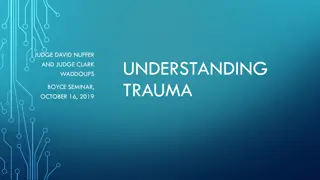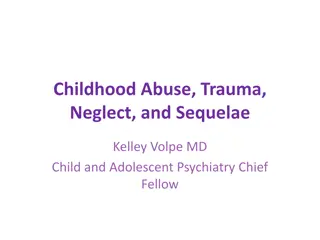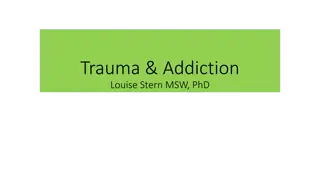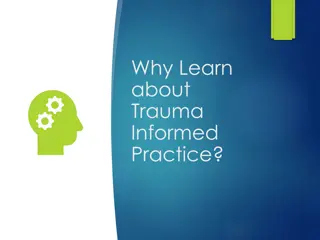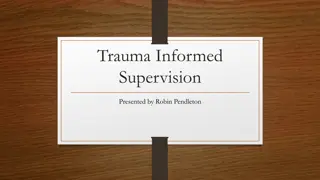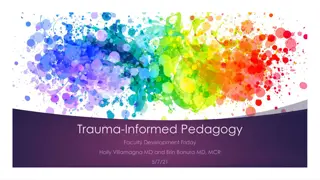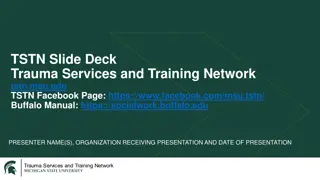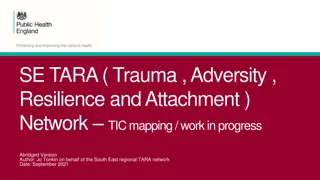Trauma in Primary Care: Clinical Insights
Explore the impact of trauma on primary care with insights from experts Dr. Stephanie Daly and Dr. Scott Cochrane. Delve into topics like adverse childhood events, toxic stress, resilience, and more. Understand the biological symptoms of trauma and learn how to identify and respond to traumatic stress effectively.
Download Presentation

Please find below an Image/Link to download the presentation.
The content on the website is provided AS IS for your information and personal use only. It may not be sold, licensed, or shared on other websites without obtaining consent from the author.If you encounter any issues during the download, it is possible that the publisher has removed the file from their server.
You are allowed to download the files provided on this website for personal or commercial use, subject to the condition that they are used lawfully. All files are the property of their respective owners.
The content on the website is provided AS IS for your information and personal use only. It may not be sold, licensed, or shared on other websites without obtaining consent from the author.
E N D
Presentation Transcript
MCPAP Clinical Conversations: Trauma in Primary Care Stephanie Daly, M.D. and Scott Cochrane, M.D. 9/26/17 1
Outline Introductions Discussion of Format Presentation Comments and Questions (15-20 mins) 2
OUTLINE Trauma Event Before Trauma After Trauma Education ACE study Core Concepts Toxic Stress Resilience* Clinic Response PTSD Resilience* Education Support Referrals Resilience Self-care 3
Adverse Childhood Events and Toxic Stress ACE Study (www.acestudy.org) Over 17,000 participants w/Kaiser Permanente Looked at 10 types of Childhood Trauma *Physical abuse *Sexual abuse *Emotional abuse *Physical neglect *Emotional neglect *Mother treated violently *Household substance abuse *Household mental illness *Parental separation or divorce *Incarcerated household member 5
ACE PYRAMID ACE FINDINGS: Almost two-thirds of participants had at least one ACE Early Death Disease, disability and social problems More than one in five reported three or more ACEs. Health Risk behaviors There is a graded dose- response relationship between ACEs and negative health and outcomes Social emotional, cognitive impairment Disrupted Neurodevelopment Adverse Childhood events CENTERS FOR DISEASE CONTROL AND PREVENTION. 6
Stress and the Body TYPES OF STRESS Positive stress; big test, performance Cortisol Tolerable stress; loss, accident Toxic Stress; abuse, neglect, exposure to violence 7
BIOLOGICAL SYMPTOMS EFFECTED BY TRAUMA: Brain Sleep: all stages of sleep cycle, nightmares Cortisol Eating: loss of appetite, hoarding, increased eating, lack of satiety Toileting: encopresis, enuresis, regression in toileting, constipation
Identifying and Responding to Traumatic Stress BE PREPARED Have connections - local CAC s, trauma informed services providers, contact to local DV shelters, peer support groups Ensure all staff know and understand protocol for making referrals to DCF (** we are reporters not investigators) Promoting Children s Health and Resiliency: A Strengthening Families Approach. AAP 10
IDENTIFING AND RESPONDING TO TRAUMTIC STRESS Look for Signs LOOK FOR THE SIGNS: Signs of exposure to Trauma - Change in behavior at home or school - Regression in development - Functional somatic complaints - Unexplained injuries or bruising - Children may react by becoming very upset for long periods, depressed, or anxious. - Changes in eating or sleeping - New onset of problems at school - Start engaging in drugs or alcohol, behave in risky ways, or engage in unhealthy sexual activity. If there are concerns about a Trauma response leading to impaired functioning or decreased quality of life = Refer to mental health services 11
Identifying and Responding to Traumatic Stress Follow UP Ensure the Child is safe (if not call Department of Children and Families) Make Referrals as need to Evidence-Based Treatments Make a plan to follow up with the family Provide education materials to parents and children Provide support for parent or caregiver Discuss protective Factors to help build resiliency Educate on effects of trauma and how it can impact child/family Encourage families to seek support for themselves and their child 1. Strengthening Families.net Center for the study of Social Development with AAP 12
Trauma PTSD Trauma occurs when a person experiences or witnesses an intense event that threatens or causes harm to the emotional and/or physical well-being of that person or someone close him/her. PTSD is a clinical diagnoses with criteria defined by DSM 5 for children 6 and older and then separate criteria for those 6 and under which includes having been exposed to a Trauma 14
PTSD DSM 5 Defined Slide from NCPTSD Trauma overview presentation 15
DSM-5 Trauma and Stressor- Related Disorders 1. Reactive Attachment Disorder 2. Disinhibited Social Engagement Disorder 3. Posttraumatic Stress Disorder 4. Acute Stress Disorder 5. Adjustment Disorders 6. Other Specified Trauma-and Stressor-Related Disorder 16
After a Trauma Event 17
12 Core Concepts: Concepts for Understanding Traumatic Stress Concepts for Understanding Traumatic Stress Responses in Children and Families Responses in Children and Families 1. Traumatic experiences are inherently complex 2. Trauma occurs within a broad context that includes children s personal characteristics, life experiences, and current circumstances 3. Traumatic events often generate secondary adversities, life changes, and distressing reminders in children s daily lives. 4. Children can exhibit a wide range of reactions to trauma and loss 5. Danger and safety are core concerns in the lives of traumatized children 6. Traumatic experiences affect the family and broader caregiving systems. 18
12 Core Concepts: Concepts for Understanding Traumatic Stress Concepts for Understanding Traumatic Stress Responses in Children and Families Responses in Children and Families 7. Protective and promotive factors can reduce the adverse impact of trauma 8. Trauma and post-trauma adversities can strongly influence development 9. Challenges to the social contract, including legal and ethical issues, affect trauma response and recovery 10. Culture is closely interwoven with traumatic experiences, response, and recovery. 11. Developmental neurobiology underlies children s reactions to traumatic experiences. 12. Working with trauma-exposed children can evoke distress in providers that makes it more difficult for them to provide good care. 19
Resilience - Definition 1. An ability to recover from or adjust easily to misfortune or change.( Webster s dictionary) 2. Resilience is the ability of a child to recover and show early and effective adaptation following a potentially traumatic event. (NCTSN) 3. Resilience is the process by which the child moves through a traumatic event, utilizing various protective factors for support, and returning to baseline in terms of an emotional and physiologic response to the stressor. (Resilience Project-AAP) 20
Resilience Project Stress Event Occurs Child Experiences Event Child Stabilizes Child receives support Resiliency Project- AAP.org 21
Resilience Project * Resilience helps children navigate stressful events * Resilience helps cushion the child from the trauma/toxic stress * Resilience helps decrease negative responses that could lead to more significant physical, emotional or behavioral issues. Resiliency Project- AAP.org 22
Increasing Resilience Protective Factors Life s Challenges Parental resiliency Knowledge of child development Social Connections Concrete support in times of need Social and emotional competence of the child 1 Neglect/Abuse Loss of a parent Failed a test Homelessness Community Violence Parental substance use Bullying 1.Strengthening Families. (n.d.). Protective Factors Framework. Retrieved May 25, 2013, from Center for the Study of Social Policy s Strengthening Families: 23
Resilience- Role of Pediatrician Parental resiliency check on parents mental health ( post-partum depression), encourage use of positive coping skills to decrease stress Knowledge of child development Education during visits to assure they have more realistic expectations of their child Social Connections- can encourage parents to develop/continue with positive social connections, can hold parent groups Concrete support in times of need- help build awareness of available resources and support around navigating service sector Social and emotional competence of the child help parents understand importance of attachment and Soc/emo development, improve confidence to bring up concerns 24
Resilience Project- Role of PCP * Education families on how to raise children who are resilient * Education families/Parents/Caretakers on building their own resiliency * Be proactive about the fact people will experience stress and discuss ways they manage this in the household * Be aware of resources in the area to help those with additional needs *Become a part of their resiliency- be a support to your patients and families 25
SELF-CARE 26
SELF CARE- PREVENTION OF SECONDARY TRAUMATIC STRESS Be aware of their own emotional reactions and distress when confronting others traumatic experiences, and know what traumatic material may trigger them. Connect with others by talking about their reactions with trusted colleagues or others who will listen. Maintain a balance between their professional and personal lives, with a focus on self-care (e.g., relaxation, exercise, stress management, etc.) to prevent, and lessen the effects of, workplace stress. 27
Secondary Traumatic Stress: Red Flags Physical Reactions Fatigue Behavioral Reactions Isolation, withdrawal Sleep disturbances Restlessness Changes in appetite Changes in alcohol or drug consumption Headaches Changes in relationships with others, personally & professionally Upset stomach Chronic muscle tension Emotional Reactions Feeling overwhelmed/ emotionally spent Sexual dysfunction Feeling helpless Cognitive Reactions Disbelief, sense of numbing Feeling inadequate Replaying events in one s mind over & over Sense of vulnerability Decreased concentration Increased mood swings Confusion or Impaired memory Irritability Difficulty making decisions or problem-solving Crying more easily or frequently Distressing dreams or fantasies Suicidal or violent thoughts or urges
MCPAP Resources for Primary Care Clinicians MCPAP Website for information, screening tools, previous webinars: https://www.mcpap.com MCPAP phone consultations for discussion of complex cases MCPAP diagnostic consultations for help with complex diagnostic evaluations MCPAP psychopharmacology consultations for help with medication management decisions Overview #2/12 29
Resources 1. American Academy of Pediatrics: A Strengthening Families Approach http://www.cssp.org/reform/strengthening-families/basic-one-pagers/Strengthening-Families-Protective-Factors.pdf 2.American Academy of Pediatrics Trauma Toolbox for Primary Care: https://www.aap.org/en-us/advocacy-and-policy/aap-health-initiatives/healthy-foster-care-america/Pages/Trauma-Guide.aspx#trauma 3.American Academy of Pediatrics Resilience Project : https://www.aap.org/en-us/advocacy-and-policy/aap-health-initiatives/resilience/Pages/default.aspx 4.National Child Traumatic Stress Network (NCTSN) : www.nctsn.org 5. ACE Study: http://www.acestudy.org/home Overview #2/12 30
Resources Mass 211 - Services Call2Talk - a National Suicide Prevention Lifeline Crisis Center. Child Requiring Assistance (CRA) Line Early Education and Child Care Services Emergency Disasters Runaway Assistance Veterans Services 32
